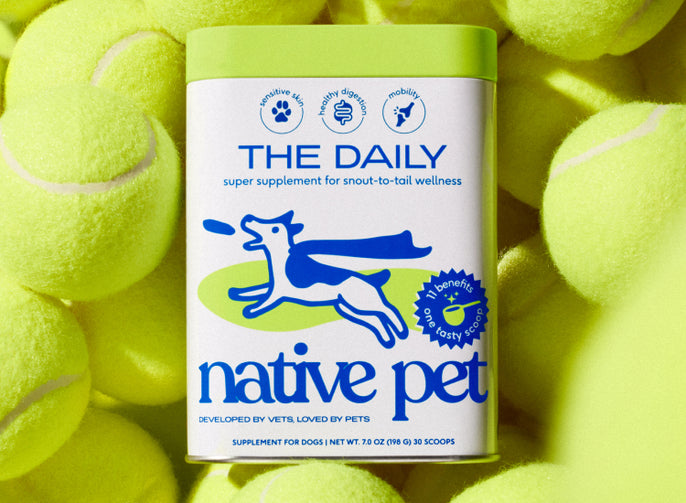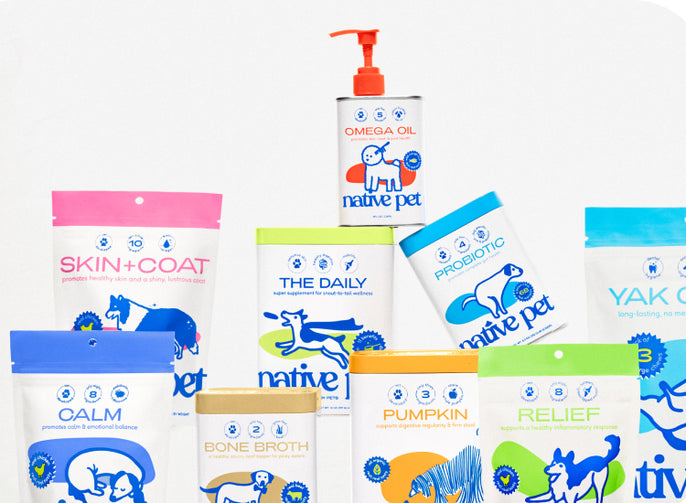By: Dr. Juli, DVM @itsdrjuli
Nothing compares to the loyal, unconditional love of a dog. Our four-legged best friends provide us with wagging tails and slobbery kisses, and they are the best exercise partners and office companions. Like people, dogs require good nutrition, exercise, and regular checkups to ensure they remain healthy until their gray muzzle years. However, the curious nature of dogs may get them into trouble if they accidentally ingest a pet-toxic food or other dangerous household items. Seizures are a common clinical sign of poisoning in pets and may be the first clue that your dog has been exposed to a toxin.
Observing your dog experiencing a seizure can feel like an eternity for pet owners. However, these temporary, involuntary disturbances of normal brain function are typically over in less than one minute. In most cases, a dog seizure is accompanied by uncontrolled muscle activity, but it may be limited to a single body part, such as an ear twitch, or a single leg movement. Take the following steps if your dog suddenly experiences a seizure:
- Avoid touching your pet to prevent an accident or injury.
- Remove any dangerous objects from the area, such as furniture with hard edges, to prevent your dog from being injured.
- Place soft blankets or padding near your seizing dog, to decrease the chance of injury.
- Time the length of the seizure, and take a video.
- Turn off any bright lights.
- Immediately call your veterinarian.

Seizure phases and signs in dogs
Most pet owners are familiar with the common seizure signs, which include muscle tremors or whole body shaking. However, subtle signs may also be present prior to your dog exhibiting more obvious seizure activity. Following a toxin exposure, a dog who has been poisoned may become anxious, clingy, unsteady, or confused. This pre-seizure, or pre-ictal, phase is the first clue that your dog is having a seizure. Recognizing seizure phases and signs will allow you to prepare and help prevent injury to you and your pet. Dog seizures include the following three phases:
- Pre-ictal – Prior to a seizure, your dog may appear restless, nervous, and clingy. This phase can last from a few seconds to a few hours.
- Ictal – The ictal, or seizure, phase signs range from mild shaking to whole-body tremors and loss of consciousness. The ictal phase can last from a few seconds to minutes. However, seizures that last more than 5 minutes are considered to be in status epilepticus.
-
Post-ictal – This phase is the period immediately after a seizure, and your dog may appear confused, disoriented, or restless.
Additionally, common toxin poisoning seizure signs may include:
- Pacing
- Confusion
- Anxiety
- Excessive panting or difficulty breathing
- Involuntary urination or defecation
- Drooling or foaming at the mouth
- Collapsing
- Muscle stiffness
- Mouth chattering or tongue chewing
- Paddling motion of the legs
- Muscle twitching
- Loss of consciousness
- Temporary blindness
Types of dog seizures
There are numerous underlying causes of seizures in dogs, and some causes may be a result of an underlying genetic abnormality. Common seizure categories in dogs include:
- Idiopathic – This seizure type is an inherited condition and the most common cause of dog seizures. The underlying cause of idiopathic seizures is not identifiable.
- Symptomatic – Structural changes in the brain from certain underlying medical conditions, including congenital deformities, tumors, infection, or inflammation can lead to symptomatic seizure activity in dogs.
- Reactive – Certain metabolic diseases, such as diabetes, can cause a reactive seizure. Accidental poisonings from dog toxin products, including some plants, medications, smoke, and certain foods can result in a reactive-type seizure.

Toxic foods that can cause seizures in dogs
It can be hard to resist your pet’s longing eyes when you are enjoying a sweet chocolate treat or a delicious salty snack. But sharing your plate with your pet can lead to gastrointestinal (GI) distress or accidental poisoning. Chocolate is a common culprit for food-induced seizures in pets. In fact, the ASPCA Animal Poison Control Center (APCC) receives more than 70 calls daily concerning chocolate toxicity, and more than 13% of calls are food-related toxicities. Pets are unable to easily metabolize the theobromine and caffeine chemicals that are present in chocolate; and dark, bitter chocolates, like baker’s chocolate, contain higher amounts of these dog-toxic chemicals. Additional chocolate toxicity clinical signs may include heart arrhythmias, agitation, and tremors. Other common seizure-inducing foods include:
- Xylitol – This popular sugar substitute is present in many sugar-free sweets, some peanut butters, sugarless gum, human gummy vitamins, nasal sprays, and toothpastes. Dogs who ingest even small amounts of xylitol can become hypoglycemic, or experience dangerously low blood sugar within 30 minutes, and the effects can last more than 12 hours. Dogs with low blood sugar levels are at high risk for seizures.
- Alcohol – Common sources of alcohol include cocktails, desserts, fermented fruits, unbaked yeast dough, some liquid medications, and mouthwashes. In addition to central nervous system disease and seizures, dogs who ingest alcohol are also at risk for GI problems, respiratory problems, liver disease, and kidney disease.
- Salt – Table salt, salty snacks, and play dough are common sources of salt poisoning in dogs. Dogs who ingest excess salt are at risk for severe illness, and death, without treatment.

Toxic human medications that can cause seizures in dogs
It may be tempting to give your dog a pain reliever when they injure their paw or accidentally hurt their leg chasing after a pesky squirrel. However, never treat your pet’s pain or discomfort with any medications unless advised to by your family veterinarian. Many over-the-counter (OTC) and prescription medications are the culprits for unexpected emergency veterinary visits, and in 2020 the APCC reported that more than 17% of calls were attributed to OTC medications. Common medications which can cause seizures in dogs include:
- Antidepressants (e.g., Cymbalta, Prozac) – Ingestion can cause disorientation, vocalization, blood pressure problems, and seizures. Dogs who ingest extended-release medications may have delayed clinical signs.
- ADHD medications (e.g., Adderall, Ritalin) – Clinical signs include agitation, vocalization, elevated body temperature, and seizures.
- Non-steroidal anti-inflammatory medications (NSAIDs) (e.g., ibuprofen, naproxen) – Many common NSAIDS are pet-toxic and can cause lethargy, GI ulcers, kidney disease, and seizures.
- Decongestants – (e.g. pseudoephedrine, phenylephrine) – Most cold medications listed with a “D” on the label, contain pseudoephedrine, and those listed “PE” have phenylephrine. While both ingredients are toxic to dogs, pseudoephedrine is considered the more dangerous toxin. In addition to seizures, these medications can cause elevated blood pressure, increased heart rate, muscle tremors, and death, in some cases.
Plants that can cause seizures in dogs
Many popular ornamental plants, flowers, and fungi are dangerous when ingested by dogs. Always check the APCC plant list to ensure any plant you are adding to your home or garden is safe to have around your dog. Additionally, fertilizers, especially organic fertilizers, can be irresistible to pets, but many contain herbicides or soil enhancements that are dangerous. Toxicity severity will depend on the amount and type of plant consumed. Seek immediate veterinary care if your dog ingests any toxic plants, which include:
- Azalea
- Brunfelsia (yesterday, today, tomorrow)
- Castor bean
- Hemlock
- Hops
- Mushrooms (Psilocybin, Isoxazole, Hydrazines)
- Marijuana
- Periwinkle
- Rhododendrons
- Sago palm
- Sweet pea
- Tulip /Narcissus bulbs

Pesticides that can cause seizures in dogs
Many pet owners are faced with the burden of unwanted houseguests, like insects and rodents. These pests often seek shelter in your home and enjoy sharing your pet’s leftover food or using your prized vegetable garden as their personal buffet. It can be tempting to take matters into your own hands (or paw) by placing commercially available pesticides around your home or garden. However, many popular pesticides and rodent baits contain ingredients that are equally appealing and potentially fatal to dogs. Always consult with a pest control professional before using any commercially available baits or poisons around your dog. Your furry pal is also at risk for seizures if they ingest these popular pest control chemicals, including:
- Bromethalin and strychnine rodenticides
- Metaldehyde based snail bait
- Pyrethrins/pyrethroids insecticides
- Zinc phosphate-based mole bait
Household products that can cause seizures in dogs
The recent pandemic has led to many people switching to a permanent home office, and dogs rejoiced when their owners no longer had to depart each morning for work. The additional time at home has also sparked many homeowners to embark on various home improvement projects, along with enhanced cleaning practices. However, exposure to popular cleaning and home improvement products can put your dog at risk for seizures. Ensure your dog does not have exposure to the following:
- Antifreeze
- Carbon monoxide fumes
- Lead-based paint
- Rubbing alcohol
- Swiffer chemicals
- Methanol-containing products including varnishes, shellacs, and adhesives
- Paint fumes
Tips for preventing a toxin-induced seizure in your dog
Keeping any toxic foods, medications, plants, and household items out of paws' reach is the most important method of preventing a toxin-induced seizure in your dog. Additionally, pets who suffer from anxiety or boredom may have an increased tendency to inappropriately sample dangerous household products or plants. Reducing your pet’s anxiety by including Native Pet’s Calm Chews into their daily nutrition can help promote normal brain activity, and reduce anxiety-related chewing. Other prevention tips include:
- Storing all OTC and prescription medications in a pet-proof container
- Gating off any home improvement projects areas, or placing your pet in a separate room when working with any toxic paints or chemicals
- Hiring a pest control professional who utilizes pet-safe options for unwanted pests
- Thoroughly rinsing surfaces of all cleaning products, to ensure there is no residue where pets may walk, including countertops


